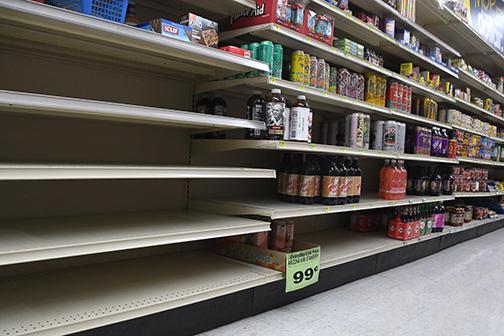Retail owners describe adjusting to shortages
Editor’s note: This is the ninth in a series of articles focused on supply chain shortages and delays and how they are impacting the local community. This report highlights feedback from local retail business owners.
If there is one place that every person can notice the recent shift in the supply change, it is when they take their regular trips to a retail store. The amount of items missing or delayed since the pandemic began continues to be one of the many inconveniences of post-shutdown life.
The effect is felt by owners of local retail businesses as well. The five businesses that participated in interviews for this report agree that the supply chain has shifted with a few changes.
Each business told of rising costs, ordering ahead sometimes up a year to ensure that inventory shows up before seasonal sales and having to switch vendors from international to national or from more local sources.
“I don’t know that we’ll ever get back to normal,” said David Sims, floor manager of Hope Home Furnishings and Flooring. “Yeah, it’s a new normal.”
Schneider’s Hardware, Home and Garden
In a joint office that overlooks the Schneider’s Hardware, Home and Garden sales floor, co-manager Jeff Schneider is looking at his computer screen longer to keep his stocks supplied.
”It’s taking more of my time to figure out a comparable item to substitute from what I normally carry,” Schneider said. “We order on Wednesdays and it would normally take me three to four hours to do the order, now I do six to eight hours on a Wednesday. It’s a full work day…It can take you an hour to find a refrigerator.”
Since the pandemic started, Schneider has had to commit more time to looking for substitutes or similar items that his DoItBest supplier might have in stock. Since the start what used to be 95 percent available on his list shrunk to 65 percent during the height of pandemic supply chain issues and has only risen 5 percent from that low since.
“It’s hard to sell from an empty store,” Schneider said. “If I don’t have a lawnmower out front, I can’t sell it. If I don’t have paint in the store, I can’t sell it.”
Items most out of stock are those requiring petroleum products, including paints, auto lubricants and plastic buckets. Larger appliances frequently are delayed or out of stock, from nine months out or with no date availability at all, especially lawnmowers.
“I placed a spring lawnmower order last September and in November they called me and said I was getting none of it,” he recalled. “Not a single one. They could not make enough to fill my warehouse (the one he orders from in Missouri) and supply me at the same time, so they were trying to get me to buy from my warehouse and not direct from them.”
The whole supply chain runs about six months behind, according to Schneider, with many spring products, like the lawnmowers, arriving in July or later. His warehouse can deliver items every Friday, though what items will be available still leads to a lot of uncertainty .
For example, paints have been strictly limited by Sherman-Williams with the number of paints available shrinking from 75 types to only the top 40 due to increased supply chain pressures.
“Companies are forced to realign their product assortment also just so that they have something to sell on the shelves,” Schneider said.
“I feel the frustration that the customer feels when he comes through the door,” he later continued. “I want to serve them and if I don’t have the products to serve them with, I feel like I let them down, even if it’s out of my control.”
The Old Homestead Floral & Gifts
For Robin Sanderson and Jennie Snoberger, co-owners and founders of The Old Homestead, getting the sweet-smelling and fresh-cut items they were used to has become a bit of a challenge.
“On our fresh flowers side, we had one that we knew would deliver every day of the week if we needed them to,” Snoberger said. “(Now), they cut back to two days a week (or) it’s three days… and their hours have shortened to where we get our fresh flowers.”
To keep the rest of the product line featuring home decorations, candles and other gifts items there is a switch to narrow the circle of production.
“On the vendor side, I think that we’re going more American-made, so we’re finding those vendors that can supply,” Sanderson said. “We’re going with local candle companies that we can meet in a local town and just put them in our trunk, bring them here.”
Another change is incorporating new and old strategies to keep up with the shortages and delays that have come over the years, as Snoberger described.
“Some of the vases that we use for flower arrangements have been hard to get because there’s a glass shortage going through COVID,” she said. “So we kind of have to learn to, I guess go back to the old school ways, of wiring and taping corsages. We used to wire the flowers and then you tape it all together. The new product is floral glue where you can cut the stem kind of shorter, we can glue them in place. It’s a lot quicker to make and they last just as well, but the floral glue had been selling.”
Overall, the local business reports a rosy, bright future for the store despite the pressures facing the wider economy.
“My experience, I would say, is COVID has taught us all how to be more creative and more adaptable,” Sanderson said. “And I think that’s been great for our business.”
Hope Home Furnishings and Floorings
Hope Home Furnishings and Floorings, also known as Hope Furniture, also suffered the familiar shock of the shutdown of manufacturing in the months after the pandemic.
“When the shutdowns hit, most of our domestic manufacturers also shut down their productions,” Sims said. “Then (we had to get) importers that were able to get the products overseas, so it became very unstable. Supply was dwindling rapidly. When things got going again, companies got back to manufacturing.”
Still, things have not returned to normal for the furniture store, including the occasional snag from major events like the Texas winter storm of 2021.
“Yeah, things started to get kind of back to normal and then the Texas ice storm that put probably the biggest impact on us,” he stated. “That was a case where the components to make foam came from those two or three plants in Texas and so it didn’t matter. The foam was in everything that we made. So that’s just pretty much (where) we went from a normal thing before the pandemic, from order to delivery was six weeks during the pandemic, then it became about six months.”
From there it is the familiar story of ordering ahead from six to nine months, adjusting prices to cover increased surcharges (freight shipping has gone from $1,500 to $3,000) and switching to different vendors, making personal orders and certain products more difficult to acquire.
“We’re proactive, like on the La-Z-Boys we had to order those every couple of weeks just to keep them in a pipeline,” said Terri Hope, owner of Hope Furniture.
With the bumpy transition to the post shutdown supply chain, the local furniture store does ask one thing from customers.
“The biggest thing is telling the customers to be patient,” Sims concluded. “It’s still a struggle for us to get things that they may want, maybe at the prices you’re going be faced with. We’re going to be faced with a higher priced product for probably another year, and it’s not something that we like, but it’s kind of the reality that we’re getting for now. So people are just going to have to be patient. We’ll get back to what I hope is a little more enjoyable shopping experience.”
Aurora Mall
The beginning of the pandemic was an interesting time for Kim Moellenberndt, manager at the Aurora Mall. He had only been on the job for a few months when the shutdown began, taking out employees and supplies.
“Oh, well, at first it was very difficult,” he said. “Yes, because we were scrapping to get anything in. Now we can almost get everything in.”
That everything does have exceptions, including baby food, with shortages impacting retailers across the nation, but there have also been affected areas of over-the-counter medicine, candy and until recently eggs. To this day there are more than 10 pages of outages, pages of orders that the vendors cannot fulfill.
“Last night in Iowa on the truck, we ordered 836 pieces and we got 522 in, so we have a third still not coming in,” Moellenberndt gave as an example. Some solutions to the crisis included taking more local options for items grown like watermelon or corn. But mostly, Moellenberndt still has to play a guessing game with the staggered out trucks that deliver on different days of the week from all the vendors that fill the shelves of the grocery store.
“Pepsi has its own company truck that comes and Coke has its own company,” he described. “Frito, our chips are all on one truck. Bread, we have two different bread companies that come in and they’re getting better again. We were short of bread for a while and now it’s getting a lot better. The shelves are almost full.”
With the supply chain seeming to stabilize into a familiar rhythm, Moellenberndt said his outlook seems be ever more positive.
“Oh, I enjoy it,” he said about having to take over before the pandemic, ending with a laugh. “I’ve been doing this my whole life basically, for about 50 years.”
The new normal seemed here to stay until the foreseeable future, but business in Hamilton County have adapted to the changing landscape of the economy to keep their community filled with locally owned retail.
If there was one other constant, it is the faith in the customer to understand the outside forces that have shifted the regular expectations of the consumer world.
“People are realizing you’re going to have to take what you can get,” Moellenberndt said. “...People are patient with this because we are always going to try to get it from somewhere.”




